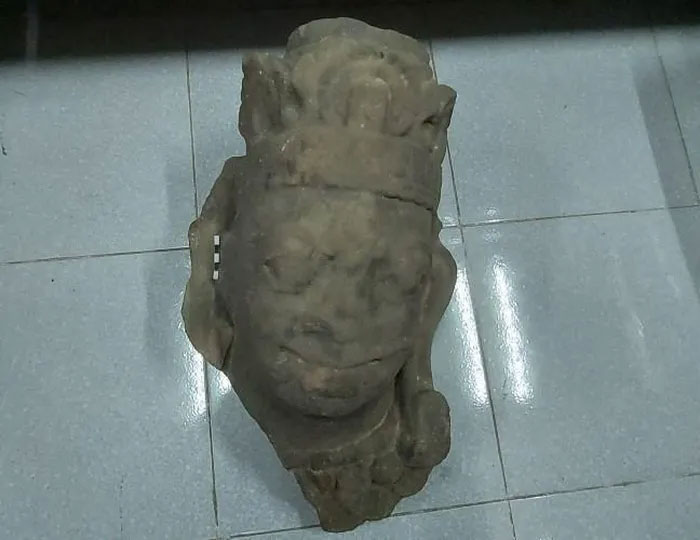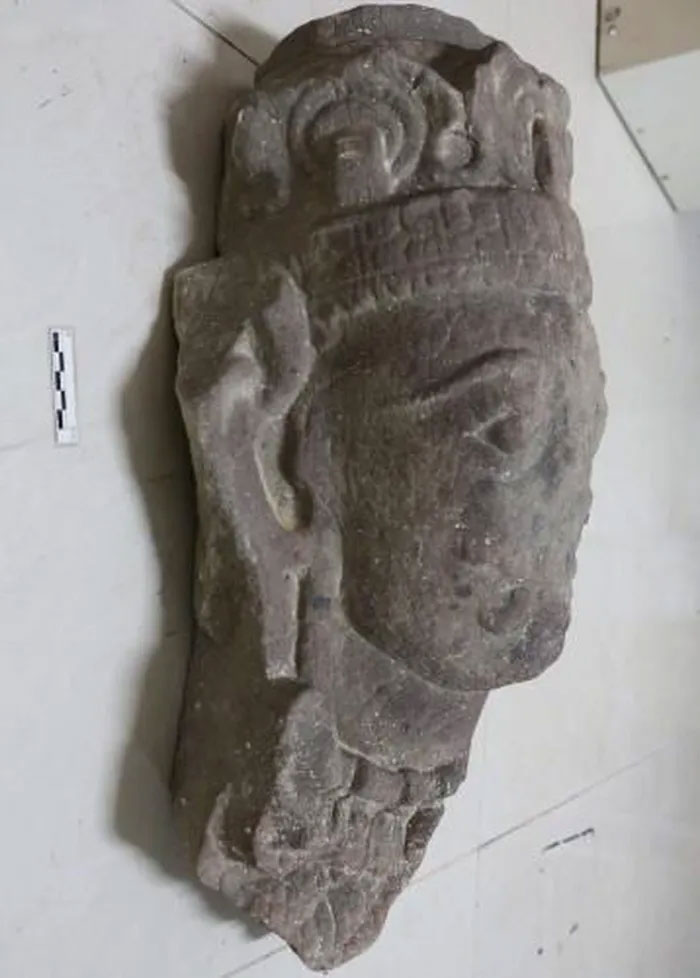A stone statue was discovered in 1979 in the core region of the Ngọc Linh mountain range in the northern part of Kon Tum province. Determining the origins of this statue is crucial to understanding the history of this land in the past.
The Secret of the Love Legend
Regarding the ancient stone statue found in Đăk Glei District (Kon Tum), Mr. Phạm Bình Vương from the Heritage Department of the Kon Tum Department of Culture, Sports and Tourism stated that relevant authorities are conducting research.
According to Mr. Vương, during a survey and inventory of historical, cultural sites, and scenic landscapes in the area, he received information about a stone statue and artifacts in Đăk Đoát village (Đăk Pek commune, Đăk Glei district).
In terms of appearance, the statue wears a lotus petal hat (with three large petals) consisting of three layers, with a rectangular stamen in the center. The lotus petal measures 13 cm wide and 10 cm high. The hatband has two parallel raised lines spaced 4 cm apart, divided into sections separated by raised lines, each section decorated with a four-petal flower and a small stamen in the center.
Additionally, below the band are 18 consecutive semicircles. The statue features large ears, thick earlobes that extend down to the shoulders, and oval-shaped earrings measuring 9 cm by 5 cm.
Moreover, the statue has a curved forehead with a raised circular pattern 6 cm in diameter in the center. The eyes are oval-shaped, with low eyebrows and a straight, flat nose with wide nostrils. The upper lip is thin with a straight mustache extending to both sides. Furthermore, the mouth is wide, with two canine teeth protruding over the lower lip, which is thick and full. The statue also has a short chin with a notch in the middle.
The chin and neck form an obtuse angle, with a thick, tall neck adorned with a necklace featuring six small bells. The bells are intricately carved, with distinct knobs and rattling beads inside. Notably, the chest is decorated with a diamond-patterned groove that resembles part of a breastplate.
According to Mr. Vương, this statue was discovered by local residents in 1979 and was brought to the People’s Committee of Đăk Glei District. By 1993, the statue was transferred to the Kon Tum Provincial Museum for safekeeping. At the time of its discovery, the statue lay exposed in the Ngọc Linh mountain range in northern Kon Tum province.
Mr. Vương mentioned that local people recounted that the area behind the statue was a high mountain, with a valley in front containing a flowing stream and many large ancient trees alongside giant boulders.
At that time, the monolithic stone statue had fallen and lay exposed, with only the head remaining. It is said that the local people referred to this statue as the hero A Đriếp, connected to a story about a beautiful wife named Bia.
A Need for Scientific Explanation


The ancient statue still holds many unanswered mysteries.
Furthermore, residents of Đăk Đoát village reported that there was a large stone block standing about 2 meters tall, with an engraving of a trident about 1 meter high, located approximately 20 cm from the A Đriếp statue. This stone block was situated on a hillside, with Ngok Yang mountain to the west, rising over 1,000 meters, and the Đăk Broi valley stretching along the Pô Kô river to the east.
Next to this site is the Đak Yang stream flowing into Đăk Broih. At the confluence of the Đak Yang and Đăk Broih streams, locals discovered many gold rings adorned with gems, gold chains, and beads made of gold.
According to Mr. Vương, there has yet to be a specific record or in-depth study of the statue. Currently, the origins of the statue remain a mystery that needs to be resolved. Many researchers have hypothesized that this statue could belong to the ancient Cham people. However, the exact time period of its creation and who made it remains inconclusive.
Mr. Vương emphasized that determining the origins of the statue is essential for understanding the historical context of the Kon Tum region in the past. Additionally, it involves excavation, research, and preservation efforts. If specialized archaeologists uncover Cham relics, it would unveil a historical narrative about how the Cham people lived in the Central Highlands.
“To answer the mysteries surrounding the statue and the discovered relics, the participation of specialized scientists is necessary,” Mr. Vương stated.
Associate Professor Dr. Nguyễn Khắc Sử, Vice Chairman of the Scientific Council and Head of the Stone Age Research Department at the Vietnam Archaeology Institute:
The stone statue discovered by locals in 1979 is a Cham Nam thần statue. It dates back to the 7th – 8th century. During a work trip leading an excavation at the Lung Leng archaeological site (a stone tool site), he accidentally discovered the foundation of a Cham tower in Kon Tum. Subsequently, some bricks from the Cham tower were taken to the Kon Tum Mission Seminary for display and preservation.
This statue indicates that there are traces of the Cham people who once lived in Kon Tum. It suggests that in the past, some Cham communities migrated to Kon Tum, engaging in trade with the Central Highlands via major rivers like the Ba River, as well as trading with Laos and Cambodia through border crossings.
In Kon Tum province, traces of the Cham people are rare, except for some bricks from Cham towers and this statue. Cham relics mainly appear in the Ayun Pa district area. To this day, remnants of towers, statues, and steles can still be found in Ayun Pa and Chư Păh districts (Gia Lai).

















































